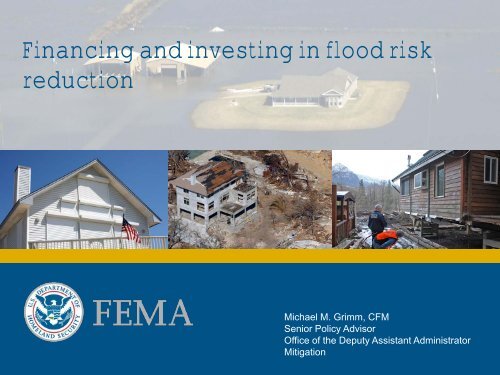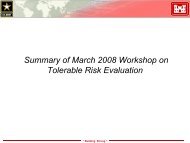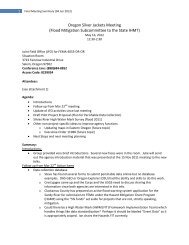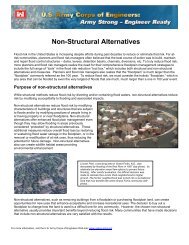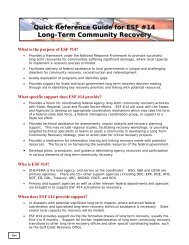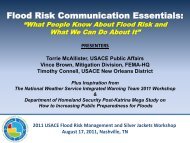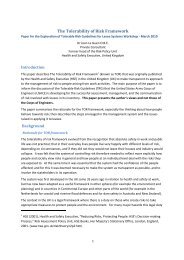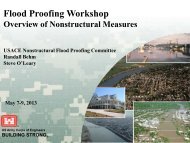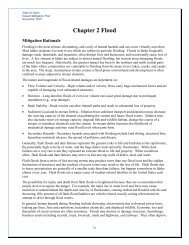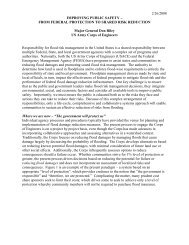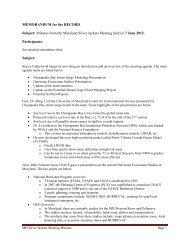Presentation - Flood Risk Management Program
Presentation - Flood Risk Management Program
Presentation - Flood Risk Management Program
- No tags were found...
You also want an ePaper? Increase the reach of your titles
YUMPU automatically turns print PDFs into web optimized ePapers that Google loves.
Overview• <strong>Flood</strong> damages continue to increase in the US, despite localefforts and federal encouragement to mitigate flood hazardsand regulate development in flood-prone areas.• Developing in flood-prone areas represents a tradeoffbetween the location’s economic and other benefits, and theexposure to a flood hazard.• Local governments are responsible for land use and zoningdecisions that shape floodplain and coastal development.• State and federal programs, policies, and investmentsinfluence community and individual decisions on managingflood risk.2
Public Policy ContextSocietalResponsibilityProtectingCitizensSustainability &ResiliencyEconomicDevelopmentIndividualAccountabilityResponsibleEnvironmental3
<strong>Flood</strong>plain Development and Insurance• US Federal policy has not prevented development in high risk areas - e.g. since1980 coastal county population growth rate (28%) is consistent with the nationsrate of increase, but density is much greater (17% percent of the land area holds53% of the total population). However, only about three percent of the USpopulation lives in a coastal flood hazard area.• <strong>Flood</strong> insurance is available in over 21,000 participating communitiesnationwide.• There are over 1100 communities participating in the financially incentive basedCommunity Rating System implementing “higher standards”, and accountingfor 66% of policies in force.• Over 80,000 insured repetitive loss properties (and growing) and over 8,000severe repetitive loss properties (and growing).• $1.2 trillion in insurance, and 5.6 million flood policies, in force• About 25% of the 5.6 million policies are rated at less than actuarial rates• Outstanding Treasury borrowing (debt) is $18.7 billion4
Disaster Assistance 2000-2009 (Fisc. Yr., all disasters types)• Avg annual Individual Assistance $ 1,531,255,266• Avg annual Public Assistance $ 3,785,161,710• Avg annual Insurance Payout $ 2,803,543,540• Non-Insured Properties $ unknown ???Total Annual Losses $8 Billion ++5
Funding Hazard Mitigation 1990-2009Post disasterPre-Disaster$ Amount in Millions6
Investments pay off $The Multi-Hazard Mitigation Council (2005) and the Congressional BudgetOffice (2007) estimates that mitigation (grants) saves society an average of$3 to $4 for every $1 spent.FEMA has estimated that as a result of implementation of the NFIP floodplainmanagement building standards, over $1.6 billion in losses are avoidedeach year.In Florida, every time the CRS Rating increases by one CRS Class, theaverage amount of flood damage decreases $303,525. (Brody et al, Journal ofAmerican Planning Association )In Texas, we found that for every real unit increase in the CRS premiumdiscount, the odds of death and injury decrease by 36 percent (Zahran et al,Journal of Environmental Planning and <strong>Management</strong> )7
Key Questions, Challenges, and Public policy issues• How can the Federal Government structure federal programs so theyprovide incentives/disincentives to reduce flood risk without infringing onprivate property rights or by-passing local decision making?• How does individual behavior translate into government action or inaction?• How can the Federal sector better influence perception of risk to drivebehavior?• In what way should we shape our public flood policy to either reduce lossesOR to subsidize risk?• How to best protect major cities, reduce risk to the nation’s infrastructure,reduce vulnerability by investing in protecting and restoring naturalfunctions, all while considering notions of equity with regard to risk andsocioeconomics?9


